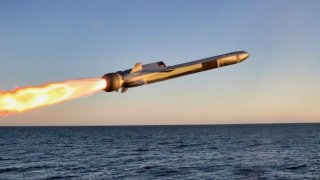Naval Strike Missile: The Ultimate Anti-Ship Weapon?
This month, the Royal Navy (RN) declared an initial operating capability (IOC) with the Kongsberg Naval Strike Missile (NSM) following the first delivery of weapons to the Type 23 frigate HMS Somerset.
This month, the Royal Navy (RN) declared an initial operating capability (IOC) with the Kongsberg Naval Strike Missile (NSM) following the first delivery of weapons to the Type 23 frigate HMS Somerset.
"HMS Somerset has received the Royal Navy's first delivery of the Naval Strike Missile, reaching IOC with the weapon system, and marking a new chapter in the surface fleet’s offensive capability. This milestone ensures the Navy continues to have a surface strike capability beyond the Harpoon out of service date," the Royal Navy said in a statement, per NavalNews.com. "The completion of a comprehensive trials package will culminate in a live firing and full operational acceptance in 2024."
The Naval Strike Missile has been adopted by multiple NATO members' navies including Norway, Poland, Germany, Romania, Canada, Spain, the UK, the Netherlands, Belgium, and most recently Latvia. It is also in service with the Australian and Malaysian navies. The United States Navy and United States Marine Corps are each part of the "NSM Club."
The Royal Navy and the NSM
The British Ministry of Defence announced in 2022 that the Royal Navy's Type 23 frigates and Type 45 destroyers will be outfitted with the Norwegian-made NSM. The missiles, which are four meters long, can strike enemy ships at a distance of more than 100 nautical miles at subsonic speeds.
The NSM will replace the existing Harpoon surface-to-surface weapons platform, which is due to be retired by the end of next year. It was developed as a collaboration between the Norwegian government and the aerospace division of Kongsberg, Norway's largest defense contractor. It is a flexible system that can be launched from a variety of platforms against both sea and land targets.
The Naval Strike Missile in the Crosshairs
According to NavalTechnology.com, the NSM is launched into the air by a solid rocket booster, which is jettisoned upon ignition. A Microturbo TRI-40 turbojet engine – a single-spool turbojet consisting of a four-stage axial compressor, annular smokeless combustor, and a single-stage turbine – propels the missile towards its target at high-subsonic speed. It can deliver a maximum thrust of 2.5kN to 3.3kN. The engine can be run on JP8 or JP10 fuel.
The NSM can fly over and around landmasses, travel in sea skim mode, and even conduct random maneuvers in the terminal phase, which makes it harder to stop by enemy countermeasures. The fifth-generation NSM is also able to navigate by GPS, inertial, and terrain reference systems. Though it was developed as an anti-ship missile, it was confirmed by the Royal Norwegian Navy that NSM also can attack land targets.
It has sea-skimming capabilities along with advanced terminal maneuvers, which allow it to evade enemy air defenses. The Autonomous Target Recognition (ATR) of the seeker units further ensures that the correct target is detected, recognized, and hit, at sea or on land. According to Kongsberg, the airframe design and the high thrust-to-weight ratio give the NSM extremely good maneuverability, while the missile is completely passive.
The NSM has been described as well-suited for land attack missions because it can climb and descend with the terrain. It was successfully tested in a land-based mobile launcher configuration in 2018 as part of a multination military exercise.
The NSM in Service
The missile was initially chosen by the Royal Norwegian Navy for its Fridtjof Nansen-class frigates and Skjold-class patrol boats. In December 2008 the NSM was selected by the Polish Navy, which ordered fifty land-based missiles (including two for testing) in deals made in 2008 and 2011, while In 2019, the U.S. Marine Corps integrated a land-based Naval Strike Missile into its force structure, sharing costs and interoperability with the Navy.
U.S.-based Raytheon was selected as the prime contractor to supply the NSM for the U.S. Navy's over-the-horizon weapons system (OTH WS) program for service with its littoral combat ships (LCS) and future frigates. The USS Gabrielle Giffords (LCS-10) launched an NSM in 2019 during Pacific Griffin, a biennial exercise conducted near Guam.
The defense contractor manufactures the NSM launchers, missiles, and components at its production facilities in the United States, with the launchers produced at the company's factory in Louisville, Kentucky, while the missile final assembly and testing are performed at its facility in Tucson, Arizona.
Air-Launched Version
The air-launched version of the NSM is known as NSM-AL. It was designed for launch from helicopters and unmanned aerial systems (UAS) and is equipped with a typical BRU-14 bomb rack, which drop-launches the missile against targets located at sea and ashore.
The NSM-AL is 3.96m long and has a launch weight of 410kg, while it can carry a 120kg warhead and has a maximum operational range of more than 180km. It is a fire-and-forget missile that can destroy high-value well-defended targets due to capabilities such as low radar cross section (RCS) and resistance to countermeasures, and enhance sea skimming. The NSM-AL is reportedly guided to the target by inertial guidance with GPS, as well as a dual-band, high-resolution intelligent imaging infrared (I3R) seeker. It follows a desired flight path programmed prior to launch.
Author Experience and Expertise
Peter Suciu is a Michigan-based writer. He has contributed to more than four dozen magazines, newspapers, and websites with over 3,200 published pieces over a twenty-year career in journalism. He regularly writes about military hardware, firearms history, cybersecurity, politics, and international affairs. Peter is also a Contributing Writer for Forbes and Clearance Jobs. You can follow him on Twitter: @PeterSuciu.


